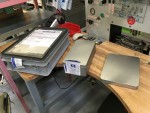Andon is for operators to help us understand quality
Andon is not for management to visualize problems, it’s for operators to help management understand quality.
Yesterday, I witnessed that rare (very rare) feat: a company trying to set up an andon. Andon means that operators have a button to switch from “all good” to “help” to “stop the line” that lights a large panel so that management can intervene. So I asked the guys setting it up a few questions.

Question #1: How will you know if it’s working?
We’ll know if problems go up the management chain and are solved. Hmm. How increasing the flow of problems will do anything else than 1) create a stock of unsolved problems (management capability to solve problems has not increased) and 2) turn operators who use the device into the source of problems (kill the messenger)?
Embarrassed silence.
Question #2: Okay, so how do we get increased productivity from andon?
Because we solve more problems faster?
We were looking at a station where the operator, before completing a simple assembly, had to check every component and visually discard the (many – the previous process is very high tech and not quite stabilized) defective ones.
After lots of stumbling back and forth: well, mechanically, if the operators learn not to 1) throw away good components that they think bad and 2) not let pass bad components that they think good, productivity will increase.
Question #3: So, what is the real role of andon?
Hmm… it’s a training tool to call a more experienced operator (team leader) at every doubt to understand in finer detail what is a good component versus a bad component, when the machine is operating well versus when the machine is being dog and so on.
When the team leader realizes the problem can’t be solved locally, she stops the line and then management’d better get involved to solve the problem quickly and get back to standard and restart the line.
Question #4: Then, what is the real purpose of andon?
It’s a tool for operators to help us really understand quality better, part by part. Don’t forget to thank them every time they pull the andon.
They are not the problem. They are not the source of the problem. They could quite happily keep working just the way they’re working now. They are helping us dig deeper into quality, not the other way around.
Question #5: How do we know the andon is working then?
We’ll know when no faulty components or sub-assemblies ever reach the next process, and when we can finally stop final inspection of 100% of parts.
What do we need to measure? Andon pulls from each station. Too many andon pulls, and we’ve got a real problem, of either process stability or operator training. Too few andon pulls, and we’ve pissed off the operator so they’ve decided not to help us out.
Just another day at the gemba, but that once more reveals the depth of our taylorist conditioning. We’re not there to fix the people. Our role as managers is to help people help us in 1) producing good parts (if an operator has a doubt about quality, respond to andon), 2) within cycle time (if an operator needs help with the cycle – respond to andon) and 3) increase variety by reducing batch size (if an operator encounters a difficulty with reference change, respond to andon).
(And, by the way, theses guys are working hard to reduce batches and reduce container size)

Lean tools are about getting closer to a single part (with Just-in-time) and looking harder at every single component (with Jidoka) to think more deeply about what we’re doing, second after second, and stop wasting operators’ valuable time. Life is spent second after second, every second is precious, and at work, should be spent adding value rather than dealing with nonsense invented by management.
Every lean tool is a tool for operators to help us figure out how to create value to generate less waste. Lean tools ARE NOT systems to “fix” operators or apply greater discipline. People are people, not machines. It’s their smiles and smarts we want, not just their hands.
One Comment










Pingback: Andon is for operators to help us understand qu...